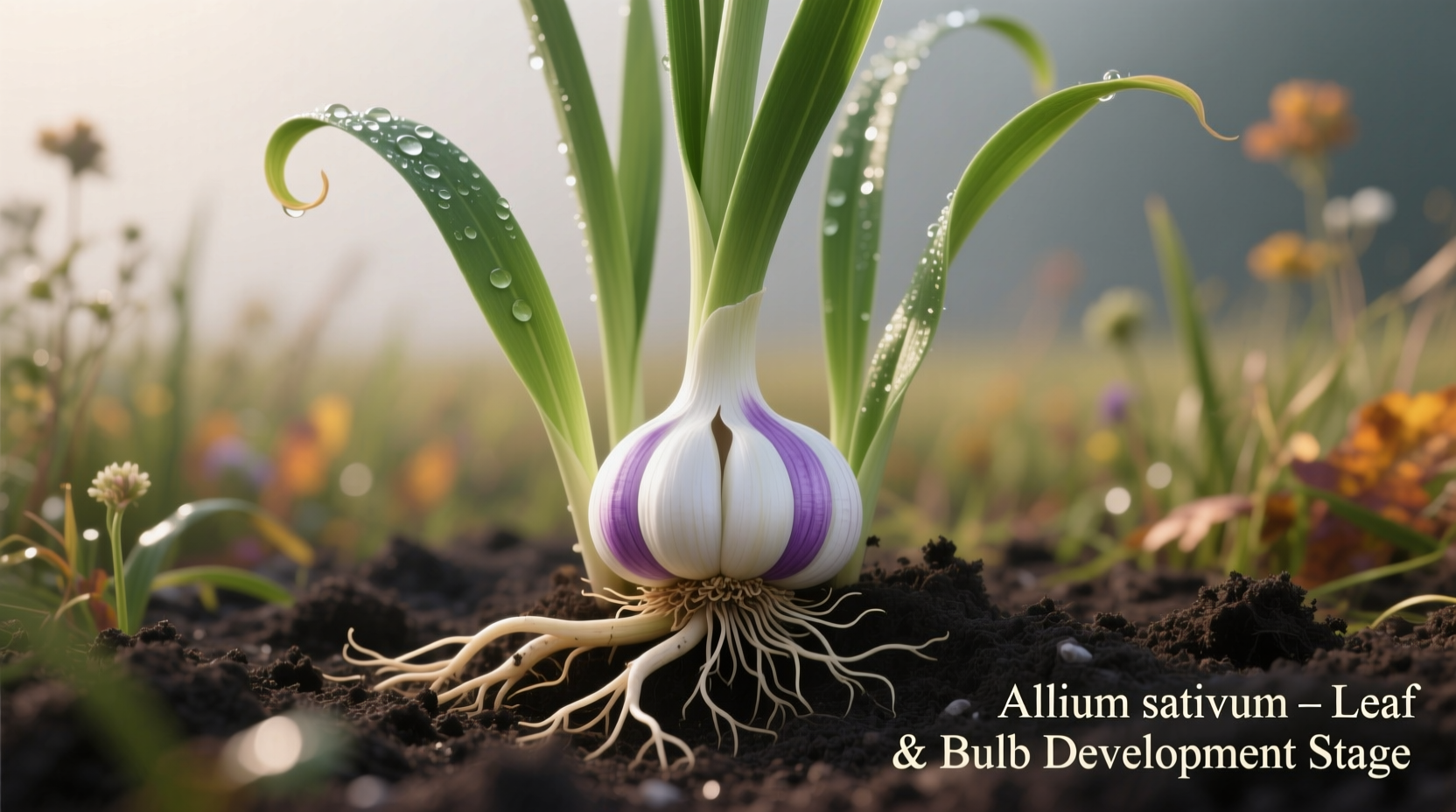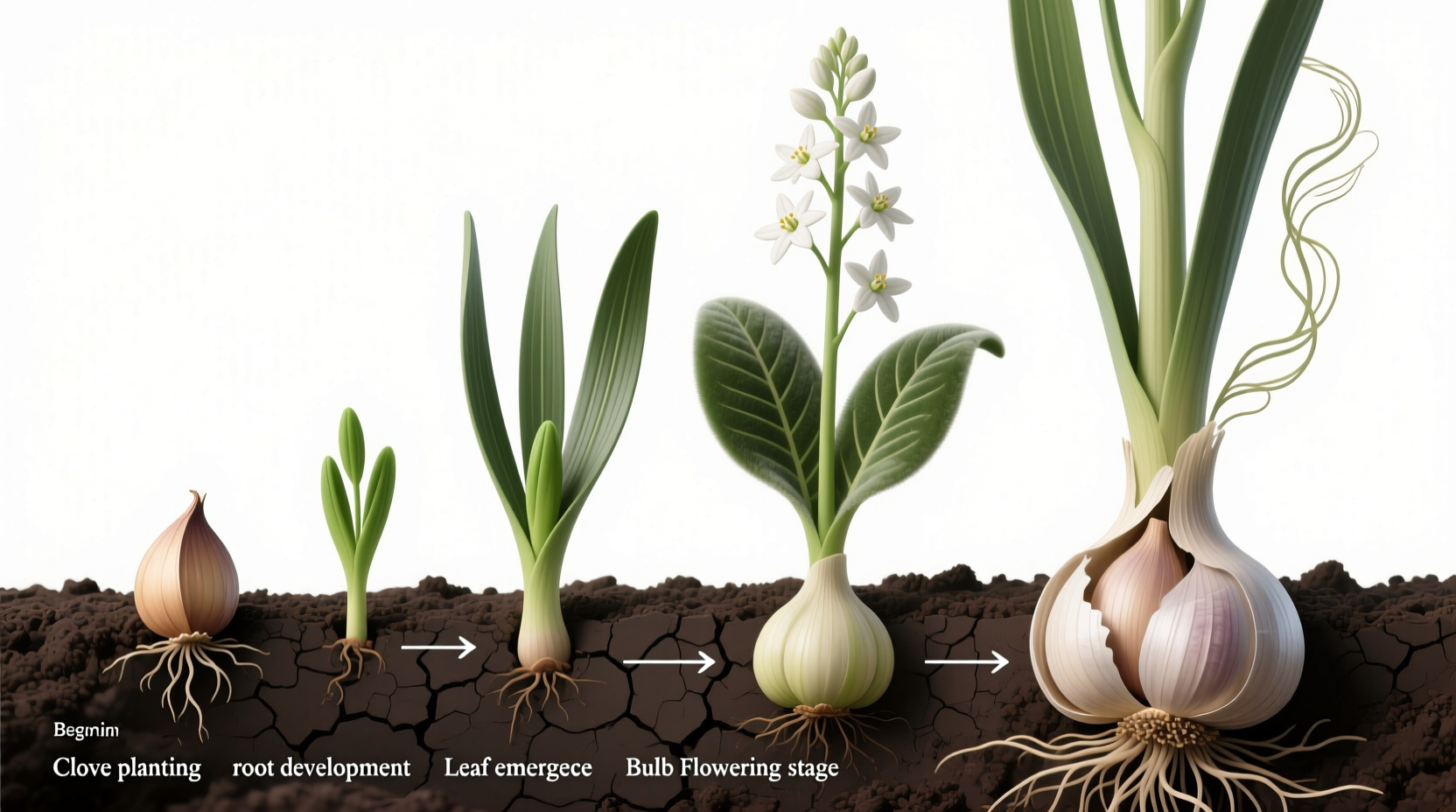The Complete Garlic Growth Journey: From Clove to Bulb
Understanding how does a garlic plant grow begins with recognizing its unique biological requirements. Unlike many garden plants, garlic follows a specific seasonal pattern that home gardeners must respect for successful cultivation. This hardy allium species (Allium sativum) completes its life cycle in one growing season when planted correctly, producing the familiar bulb we use in cooking.
Garlic Growth Timeline: What Happens Month by Month
Garlic's growth process follows a predictable seasonal pattern that varies slightly by climate zone. This garlic plant development timeline provides what to expect throughout the growing season:
| Time Period | Growth Stage | Visible Changes | Critical Requirements |
|---|---|---|---|
| September-November | Planting & Root Development | No visible top growth | 45-50°F soil temperature, well-draining soil |
| December-February | Vernalization Period | Minimal top growth, root expansion | 30-50 days below 40°F for bulb formation |
| March-April | Leaf Growth Phase | Rapid leaf production (4-12 leaves) | Consistent moisture, nitrogen-rich soil |
| May-June | Bulb Formation | Swelling at base, scapes appear (hardneck) | 14+ hours daylight, reduced watering |
| July | Maturation & Harvest | Lower leaves yellow/brown, bulb wrappers dry | Dry conditions, stop watering 2 weeks prior |
This timeline, verified by Oregon State University Extension, shows why timing your planting correctly is crucial. Garlic requires that cold period (vernalization) to initiate bulb formation—without sufficient cold exposure, you'll get only green tops with no bulb development.
Planting Your Garlic: Getting Started Right
The garlic planting process for beginners starts with selecting quality cloves. Never use grocery store garlic, which may be treated to prevent sprouting or carry diseases. Instead, source seed garlic from reputable growers. Here's what successful planting requires:
- Timing: Plant 4-6 weeks before first hard frost (typically September-November in northern zones)
- Soil preparation: Amend with compost to achieve loose, well-draining soil with pH 6.0-7.0
- Planting depth: Place cloves 2-3 inches deep with pointed end up
- Spacing: Allow 6-8 inches between plants in rows 12-18 inches apart
- Mulching: Apply 4-6 inches of straw after ground cools to regulate temperature
According to research from USDA Agricultural Research Service, proper planting depth directly affects bulb size—too shallow leads to smaller bulbs, while too deep delays emergence.
Hardneck vs. Softneck: Understanding Growth Differences
When learning how garlic grows in garden conditions, recognizing the two main types is essential. Their growth patterns differ significantly:
| Characteristic | Hardneck Garlic | Softneck Garlic |
|---|---|---|
| Cold Hardiness | Excellent (thrives in zones 3-7) | Moderate (better in zones 5-9) |
| Scapes | Produces edible flower stalks (remove for larger bulbs) | No scapes |
| Bulb Formation Trigger | Day length sensitive (forms bulbs at 14+ hours) | Less day-length sensitive |
| Storage Life | 5-8 months | 9-12 months |
| Flavor Profile | Stronger, more complex | Milder, more consistent |
This comparison, based on data from University of Minnesota Extension, explains why hardneck varieties dominate northern gardens while softnecks perform better in milder climates. Hardnecks produce scapes in late spring—curly flower stalks that should be removed to redirect energy to bulb development.
Seasonal Care: Supporting Healthy Garlic Growth
Throughout the garlic plant growth stages explained, your care approach should change with the seasons:
Fall & Winter Care
After planting, water once to settle soil, then let nature take over. In colder zones, apply straw mulch after the ground cools but before hard freezes. This protects against temperature fluctuations that cause cloves to heave from the soil.
Spring Growth Phase
As temperatures warm, remove mulch to allow shoots to emerge. Once established, garlic needs 1 inch of water weekly. Side-dress with nitrogen-rich fertilizer when leaves reach 8 inches tall. For hardneck varieties, monitor for scapes and remove them when they form their first loop.
Summer Bulb Formation
When daylight reaches 14 hours (typically May in northern zones), bulb formation begins. Reduce watering gradually as harvest approaches. Stop watering completely 2-3 weeks before harvest when lower leaves start yellowing. This curing process in the ground improves storage quality.

Harvesting: Recognizing the Perfect Moment
Timing your harvest correctly is the final critical step in understanding garlic plant development. Harvest too early and bulbs won't be fully formed; too late and wrappers deteriorate, reducing storage life. Watch for these signs:
- Lower 40% of leaves have turned brown or yellow
- Bulb wrappers are dry and papery
- Individual cloves are distinct and fill out the wrapper
Use a garden fork to carefully loosen soil around plants before lifting. Never pull garlic from the ground, as this can damage the neck. After harvesting, cure bulbs in a warm, dry, shaded location with good air circulation for 2-3 weeks before trimming and storing.
Troubleshooting Common Growth Problems
Even with proper care, garlic growing challenges may arise. Here's how to address frequent issues:
- Small bulbs: Caused by late planting, insufficient cold period, or overcrowding. Plant earlier, ensure proper vernalization, and space cloves adequately.
- Yellowing leaves: Could indicate overwatering, nutrient deficiency, or pest damage. Check soil moisture and consider soil test.
- No bulb formation: Usually means insufficient cold exposure. Try different variety better suited to your climate.
- Mold on bulbs: Results from wet conditions during growth or improper curing. Improve drainage and ensure proper curing conditions.
According to Cornell University's Home Gardening Resources, rotating garlic to a new location every 3-4 years prevents soil-borne disease buildup that can stunt growth.
From Garden to Kitchen: Maximizing Your Harvest
After successfully growing garlic, proper storage extends your harvest. Store cured bulbs in mesh bags or braids in a cool (55-65°F), dark location with 60-70% humidity. Hardneck varieties typically store 5-8 months, while softnecks last 9-12 months. For immediate use, separate cloves but leave wrappers intact until ready to cook.
Understanding how garlic grows from planting to harvest transforms your gardening success and appreciation for this culinary staple. By respecting garlic's natural growth cycle and providing appropriate seasonal care, you'll enjoy robust bulbs perfect for enhancing your favorite dishes.











 浙公网安备
33010002000092号
浙公网安备
33010002000092号 浙B2-20120091-4
浙B2-20120091-4